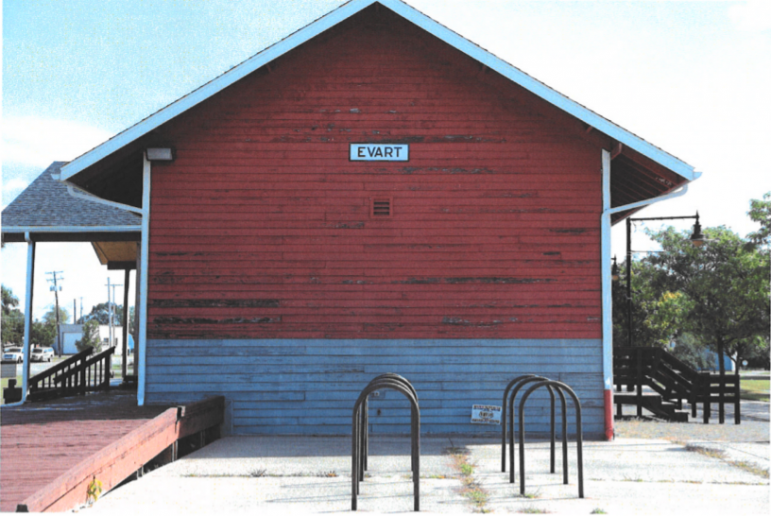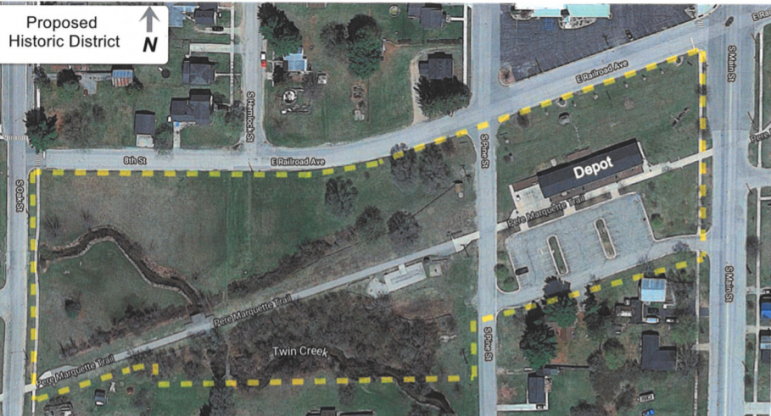By DANIELLE JAMES
Capital News Service
LANSING – In 1872, the Flint and Pere Marquette Railroad constructed the Evart depot as a stopping point along its route.
It’s believed that the wooden building, located on East Railroad Avenue in Evart, was used for over 100 years until the last train left the station in 1989, pulling the tracks up behind it.
The depot was rediscovered and renovated in the early 1990s and converted into city hall. However, high maintenance costs and outdated systems led again to its abandonment – and it’s stayed that way ever since.
Local officials are trying to change that.
The building is a 19th century wood-framed railroad station with much of the original framework and design elements still intact. The design was at one point quite common across Michigan, but many similar buildings have since been demolished.
The rescue plan has three parts, according to Mark Wilson, the Evart zoning administrator and head of the Department of Public Works.
“We’re trying to establish a historic district, including property around the depot, get the building on the National Register of Historic Places and obtain certified local government status through the State [Historic] Preservation Office,” Wilson said.
“We’re working through each one of those as we go because they have different requirements and reports,” he said.
The city created a historic district study committee last July to oversee the depot’s application process.
According to Wilson, the committee has applied to become a certified local government program, which would let it participate directly in identification and preservation of historic properties. It also started the application process to add the depot to the National Register of Historic Places, a program of the National Park Service.
“We’ve heard back on both of those that the depot is eligible,” Wilson said, “and now we’re working on the final report.”
According to Todd Walsh, the national register coordinator for the State Historic Preservation Office, the depot qualifies because of its historic significance to the transportation industry.
“We evaluated the Flint and Pere Marquette railroad depot as significant for its association with the transportation history of Evart,” Walsh said. “In this case, the presence of the railroad in Evart had a significant impact on the city, and the depot embodies and illustrates that history.”
According to Walsh, the designation wouldn’t place any restrictions on the property, but it can lead to tax credits and increased opportunities for funding.
“Some funding programs and funding organizations require or look favorably upon properties listed in the National Register,” Walsh said. “Listing in the National Register can also serve as a marketing tool, a generator of heritage and cultural tourism, and can contribute to community pride.”
However, Walsh said the listing process is lengthy. Applicants put together a nomination, which is first sent to the state preservation office, then a state review board and finally the National Park Service.
“In such a case, experts at every level – local, state, and national – have reviewed the same information and have all agreed that a particular site is significant,” Walsh said. “For someone to do the work and to meet the expectations of so many people at so many levels is truly something special.”
In addition to receiving national historic status, Wilson said the ultimate goal is to restore the building and use it once again as city hall.
“In the early 1990s, our local finance authority worked through some grants to purchase the building from the railroad and try to rehabilitate the structure while maintaining the historic integrity of the building,” Wilson said.
“The building was rehabilitated and we moved our city hall into the building, but it was basically preserved in its original condition, and over the years it required a lot of work to maintain it,” he said.
According to Wilson, an outdated heating system and a mold problem in the basement forced local government to abandon the city offices.
Evart’s city hall is now in the municipal airport.
“We did have the mold issue remediated, and we put a new roof on the building, but we stayed moved out,” Wilson said. “With our city council at the time, there was kind of a mixed opinion on going back and a push to build a new city hall.
“There was a lot of information that was misunderstood, and a lot of people saying that we couldn’t do anything to the building to modernize it,” he said, “so we approached the State Historic Preservation Office to find out what we could do to the building.”
In addition to gaining more information, Wilson said that a change in city leadership helped fuel the push to restore the old building.
“We also had an election and gained some new council members, so we now have a council that wants to renovate the building instead of building a new city hall,” Wilson said. “Our goal is preservation and being able to get city hall back into that building.”
Wilson said the committee plans to reach out to historic preservation specialist Grace Smith of Rockford, who helped write the original proposal, for assistance in completing the process.
In addition to helping the depot get on the National Register, Smith said her role was to assist the committee in renovating the building. According to her original proposal, those renovations must be carefully considered.
“Since there is a significant amount of integrity in the location and quantity of historic materials still on this building, it is important to retain as much of this integrity while preparing the building for a more energy efficient future,” she said.
“It is necessary to minimize the maintenance requirements and minimize the negative impact that alterations could have on the historic features that still exist,” she said.
According to the proposal, the best way to preserve the building is to make it functional for daily use.
Smith said, “That is the only practical way to really save a building and fend off deterioration.”
Smith said she believes that past renovations haven’t hurt the historic significance of the building. “With the previous renovation, I think they did the best job they could. Some renovations are inevitable with buildings as they age.
“It’s really nice when a small town respects a building enough to continue to use it themselves instead of trying to sell it,” she said. “They realize how important their history is to them.”

